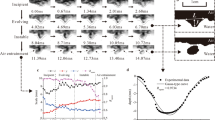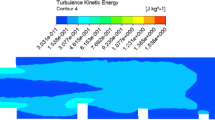Abstract
In hydraulic structures, free-surface aeration is commonly observed: i.e., the white waters. The air bubble entrainment may be localised (hydraulic jumps, plunging jets) or continuous along an interface (water jets, chutes). Despite recent advances, there are some basic concerns about the extrapolation of laboratory results to large size prototype structures. Herein the basic air bubble entrainment processes are reviewed and the relevant dynamic similarities are discussed. Traditionally, physical studies are conducted using a Froude similitude which implies drastically smaller laboratory Reynolds numbers than in the corresponding prototype flows. Basic dimensional analyses are developed for both singular and interfacial aeration processes. The results are discussed in the light of systematic investigations and they show that the notion of scale effects is closely linked with the selection of relevant characteristic air–water flow properties. Recent studies of local air–water flow properties highlight that turbulence levels, entrained bubble sizes and interfacial areas are improperly scaled based upon a Froude similitude even in large-size models operating with the so defined Reynolds numbers ρ w × q w/μ w up to 5 E+5. In laboratory models, the dimensionless turbulence levels, air–water interfacial areas and mass transfer rates are drastically underestimated.
Similar content being viewed by others
References
Anwar HO (1994) Self-aerated flows on chutes and spillways—discussion. J Hydraul Eng ASCE 120(6): 778–779
BaCaRa (1991) Etude de la Dissipation d’Energie sur les Evacuateurs à Marches. (Study of the energy dissipation on stepped spillways) Rapport d’Essais, Projet National BaCaRa, CEMAGREF-SCP, Aix-en-Provence, France, October, 111 pp (in French)
Barenblatt GI (1996) Scaling, self-similarity, and intermediate asymptotics. Cambridge University Press, UK, p 386
Boes RM (2000) Scale effects in modelling two-phase stepped spillway flow. In: Minor HE, Hager WH (eds) International workshop on hydraulics of stepped spillways. Balkema Publ, Zürich, pp 53–60
Boes RM, Hager WH (2003) Two-phase flow characteristics of stepped spillways. J Hydraul Eng ASCE 129(9): 661–670; discussion 131(5):419–429
Brocchini M, Peregrine DH (2001) The dynamics of strong turbulence at free surfaces. Part 2. Free-surface boundary conditions. J Fluid Mech 449: 255–290
Cain P (1978) Measurements within self-aerated flow on a large spillway. PhD Thesis, Ref. 78–18. Department of Civil Engineering, University of Canterbury, Christchurch, New Zealand
Cain P, Wood IR (1981) Instrumentation for aerated flow on spillways. J Hydraul Div ASCE 107(HY11): 1407–1424
Carosi G, Chanson H (2006) Air–water time and length scales in skimming flows on a stepped spillway. Application to the spray characterisation. Report No. CH59/06. Division of Civil Engineering, The University of Queensland, Brisbane, Australia, July, 142 pp
Cartellier A, Achard JL (1991) Local phase detection probes in fluid/fluid two-phase flows. Rev Sci Instrum 62(2): 279–303
Chanson H (1993) Self-aerated flows on chutes and spillways. J Hydraul Eng ASCE 119(2): 220–243; discussion 120(6):778–782
Chanson H (1995) Air bubble diffusion in supercritical open channel flow. In: Bilger RW (ed) Proceedings of 12th Australasian fluid mechanics conference AFMC, vol 2, Sydney, Australia, pp 707–710
Chanson H (1997) Air bubble entrainment in free-surface turbulent shear flows. Academic Press, London, p 401
Chanson H (2002) Air–water flow measurements with intrusive phase-detection probes. Can we improve their interpretation?. J Hydraul Eng ASCE 128(3): 252–255
Chanson H (2004) The hydraulics of open channel flow: an introduction, 2nd edn. Butterworth-Heinemann, London, p 630
Chanson H, Carosi G (2007) Turbulent time and length scale measurements in high-velocity open channel flows. Exp Fluids 42(3): 385–401. doi:10.1007/s00348-006-0246-2
Chanson H, Felder S (2007) Dynamic similarity and scale effects in turbulent free-surface flows above triangular cavities. In: Jacobs P, Mcintyre T, Cleary M, Buttsworth D, Mee D, Clements R, Morgan R, Lemckert C (eds) Proceedings of 16th Australasian Fluid Mechanics Conference AFMC, Gold Coast, Australia, 2–7 December, pp 691–698 (CD-ROM)
Chanson H, Gonzalez CA (2005) Physical modelling and scale effects of air–water flows on stepped spillways. J Zhejiang Univ Sci 6A(3): 243–250
Chanson H, Gualtieri C (2008) Similitude and scale effects of air entrainment in hydraulic jumps. J Hydraul Res IAHR 46(1): 35–44
Chanson H, Manasseh R (2003) Air entrainment processes in a circular plunging jet. Void fraction and acoustic measurements. J Fluids Eng Trans ASME 125(5): 910–921
Chanson H, Toombes L (2002a) Air–water flows down stepped chutes: turbulence and flow structure observations. Int J Multiphase Flow 28(11): 1737–1761
Chanson H, Toombes L (2002b) Experimental study of gas–liquid interfacial properties in a stepped cascade flow. Environ Fluid Mech 2(3): 241–263
Chanson H, Toombes L (2002c) Energy dissipation and air entrainment in a stepped storm waterway: an experimental study. J Irrig Drain Eng ASCE 128(5): 305–315
Chanson H, Aoki S, Hoque A (2002a) Similitude of air bubble entrainment and dispersion in vertical circular plunging jet flows. An experimental study with freshwater, salty freshwater and seawater. Coastal/Ocean Engineering Report No. COE02-1. Department of Architecture and Civil Engineering, Toyohashi University of Technology, Japan, 94 pp
Chanson H, Yasuda Y, Ohtsu I (2002b) Flow resistance in skimming flows and its modelling. Can J Civil Eng 29(6): 809–819
Chanson H, Aoki S, Hoque A (2004) Physical modelling and similitude of air bubble entrainment at vertical circular plunging jets. Chem Eng Sci 59(4): 747–754
Chanson H, Aoki S, Hoque A (2006) Bubble entrainment and dispersion in plunging jet flows: freshwater versus seawater. J Coastal Res 22(3): 664–677
Chirichella R, Gomez Ledesma R, Kiger KT, Duncan JH (2002) Incipient air entrainment in a translating axisymmetric plunging laminar jet. Phys Fluids 14(2): 781–790; discussion 14(9):3367–3368
Crowe C, Sommerfield M, Tsuji Y (1998) Multiphase flows with droplets and particles. CRC Press, Boca Raton, p 471
Cummings PD, Chanson H (1999) An experimental study of individual air bubble entrainment at a planar plunging jet. Chem Eng Res Design Trans I-Chem E, Part A 77(A2): 159–164
Ehrenberger R (1926) Wasserbewegung in steilen Rinnen (Susstennen) mit besonderer Berucksichtigung der Selbstbelüftung. (Flow of water in steep chutes with special reference to self-aeration) Zeitschrift des Österreichischer Ingenieur und Architektverein, No. 15/16 and 17/18 (in German) (Trans: Wilsey EF, U.S. Bureau of Reclamation)
El Hammoumi M (1994) Entraînement d’Air par Jet Plongeant Vertical. Application aux Becs de Remplissage pour le Dosage Pondéral (Air entrainment by vertical plunging jet. application to refill nozzles applied to dosage). PhD thesis, INPG, Grenoble, France (in French)
Ervine DA, Falvey HT (1987) Behaviour of turbulent water jets in the atmosphere and in plunge pools. Proc Instn Civ Engrs. London, Part 2, March 1987, 83:295–314; discussion: Part 2, March–June 1988, 85:359–363
Ervine DA, Mckeogh EJ, Elsawy EM (1980) Effect of turbulence intensity on the rate of air entrainment by plunging water jets. Proc Instn Civ Engrs, Part 2, June, pp 425–445
Gonzalez CA, Chanson H (2004) Interactions between cavity flow and main stream skimming flows: an experimental study. Can J Civ Eng 31(1): 33–44
Henderson FM (1966) Open channel flow. MacMillan Company, New York
Heraud D (1966) Dispersion des Jets Liquides; Influence des Rugosités de Paroi. PhD thesis, University Grenoble 1, France
Hinze JO (1955) Fundamentals of the hydrodynamic mechanism of splitting in dispersion processes. J AIChE 1(3): 289–295
Hoyt JW, Taylor JJ (1977) Waves on water jets. J Fluid Mech 83(Pt 1): 119–127
Keller RJ (1972) Field measurement of self-aerated high speed open channel flow. PhD thesis, Department of Civil Engineering, University of Canterbury, New Zealand
Kobus H (1984) Scale effects in modelling hydraulic structures. Proceedings of international symposium on scale effects in modelling hydraulic structures. IAHR, Esslingen, Germany
Kolaini AR (1998) Sound radiation by various types of laboratory breaking waves in fresh ans salt water. J Acoust Soc Am 103(1): 300–308
Mckeogh EJ (1978) A study of air entrainment using plunging water jets. PhD thesis, Queen’s University of Belfast, UK, 374 pp
Murzyn F, Chanson H (2007) Free surface, bubbly flow and turbulence measurements in hydraulic jumps. Report CH63/07, Division of Civil Engineering, The University of Queensland, Brisbane, Australia, August, 116 pp, ISBN 9781864998917
Rajaratnam N (1962) An experimental study of air entrainment characteristics of the hydraulic jump. J Inst Eng India 42(7): 247–273
Rao NSL, Kobus HE (1971) Characteristics of self-aerated free-surface flows. Water and waste water/current research and practice, vol 10. Eric Schmidt Verlag, Berlin, Germany
Resch FJ, Leutheusser HJ (1972) Le Ressaut Hydraulique: mesure de Turbulence dans la Région Diphasique. J La Houille Blanche 4: 279–293
Scott JC (1975) The preparation of water for surface clean fluid mechanics. J Fluid Mech 69(Part 2): 339–351
Straub LG, Anderson AG (1958) Experiments on self-aerated flow in open channels. J Hydraul Div Proc ASCE 84(HY7):1890-1–1890-35, paper 1890
Toombes L, Chanson H (2005) Air–water mass transfer on a stepped waterway. J Environ Eng ASCE 131(10): 1377–1386
Wood IR (1991) Air entrainment in free-surface flows. IAHR hydraulic structures design manual no. 4, Hydraulic design considerations. Balkema Publ., Rotterdam, The Netherlands, 149 pp
Author information
Authors and Affiliations
Corresponding author
Rights and permissions
About this article
Cite this article
Chanson, H. Turbulent air–water flows in hydraulic structures: dynamic similarity and scale effects. Environ Fluid Mech 9, 125–142 (2009). https://doi.org/10.1007/s10652-008-9078-3
Received:
Accepted:
Published:
Issue Date:
DOI: https://doi.org/10.1007/s10652-008-9078-3




